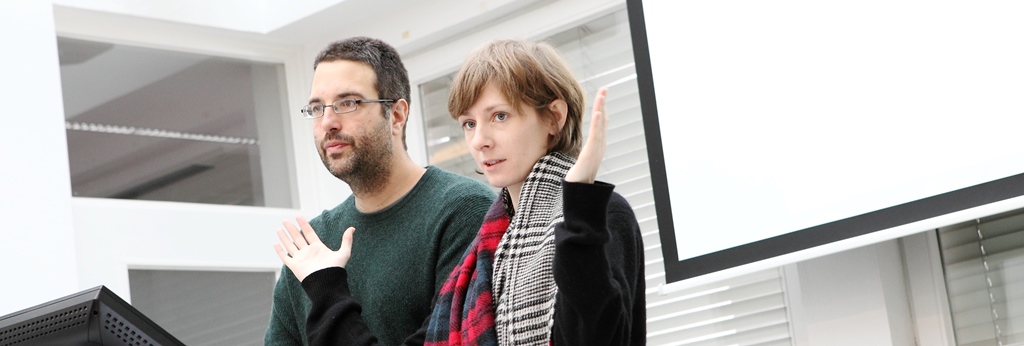Challenging questions at the intersections of art, pedagogy, and research
An Interview with microsillons (Marianne Guarino-Huet and Olivier Desvoignes) by Laila Huber and Elke Zobl
What different audiences do you work with?
Marianne Guarino-Huet: There are various audiences. For four years we were responsible for art education projects at the Centre d’Art Contemporain Geneve. We wanted to develop art education through projects and we had the opportunity to do so in that institution. We also worked with a lot of schools.
Olivier Desvoignes: Community houses, also with groups that are more mixed. And with future art teachers, students in graphic design, in communication, journalism…
Marianne Guarino-Huet: It is very different from one project to another: when we are working with a group sharing an interest or a practice or a class of pupils. The dynamics and the relationship are completely different.
Olivier Desvoignes: Maybe one comment we can make regarding the audience is that it demands that we work locally. We also deal with projects in different contexts, but for us, when we are invited to do something in a remote context, a big part of the project is always to define our position and really be very extra careful about why we are there, what we can actually do with the group, etc. When we are in Geneva, we know the context, and we know it better project after project. Quite often in collaborative projects there is this idea of working with “the other,” and this is sometimes linked to the idea of targeted audiences. There is this kind of otherness that is sought. When we are working with classes in Geneva, we feel closer and for us it is also a more accurate position.
Marianne Guarino-Huet: Perhaps in trying to describe the different types of collaborations and groups we are collaborating with, we can talk about circles, different circles that we can imagine as “exocentric.” We have developed a mobile office, the “Bureau Mobile.” We did a 24-hour tour in Geneva with it and invited thirty different artists and cultural workers to take part. In that project, each artistic proposal generated another circle of people who were willing to participate in the performance, so this was another way to collaborate, not on the long term like the experience we described before, but with a more interventionist approach. This idea of developing different circles and seeing how you can get them to talk, to mix at some point, is really how we try to do our artwork.
Can you explain a bit more about the “Bureau Mobile”? Could it be understood as a tool box?
Olivier Desvoignes: It is definitely a tool box. We really meant it as something quite functional and not as an artwork in itself somehow. Even though it was conceived with a designer and it is also a clear reference to that USM Haller system, that very classical Swiss office design. We used the USM as a kind of joke because it was completely distorted. But the idea is that it can be functional. The idea began from our experience of working with different institutions and never having a place to work, always having to work in the corridors or on the floor.
Marianne Guarino-Huet: We were always carrying all our materials with us and we wanted to make sure that if we needed to print something, for example, everything was working. We applied for a grant for art educators from the city of Geneva, with the concept of this mobile office. If it is a tool box, it is also a way to address the production conditions of cultural work. How can you imagine working without a space?
Olivier Desvoignes: It was also a strategy for financing our activities rather than just for a project. Austria was a very important place for independent art education— with practices a few years ago such as “StörDienst” or “trafo.K.” In Switzerland, this independent art education is an emerging field. So for us it was also a kind of strategic move to say; what we need is material, it is time to think about the specificities of our practice. It worked out and we were able to build that office. We can go with it to an institution or we can develop things completely outside of the institution. The idea of autonomy was very important: we are energy-autonomous for a few hours. We did exhibitions, screenings, parties, etc., in the streets.
Laila Huber, Elke Zobl, microsillons – Olivier Desvoignes/Marianne Guarino-Huet ( 2014): Challenging questions at the intersections of art, pedagogy, and research. An Interview with microsillons (Marianne Guarino-Huet and Olivier Desvoignes) by Laila Huber and Elke Zobl . In: p/art/icipate – Kultur aktiv gestalten # 05 , https://www.p-art-icipate.net/challenging-questions-at-the-intersections-of-art-pedagogy-and-research/


 Artikel drucken
Artikel drucken Literaturverzeichnis
Literaturverzeichnis